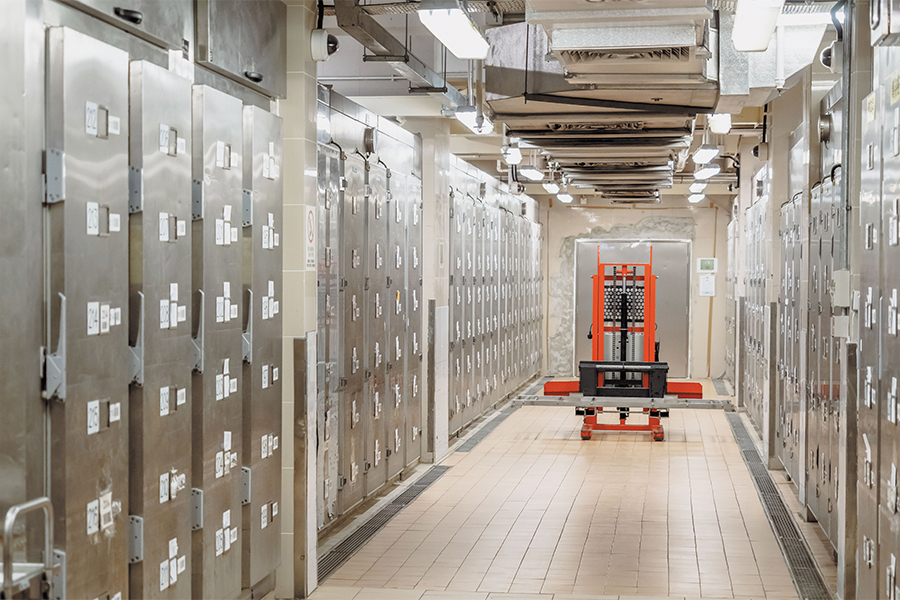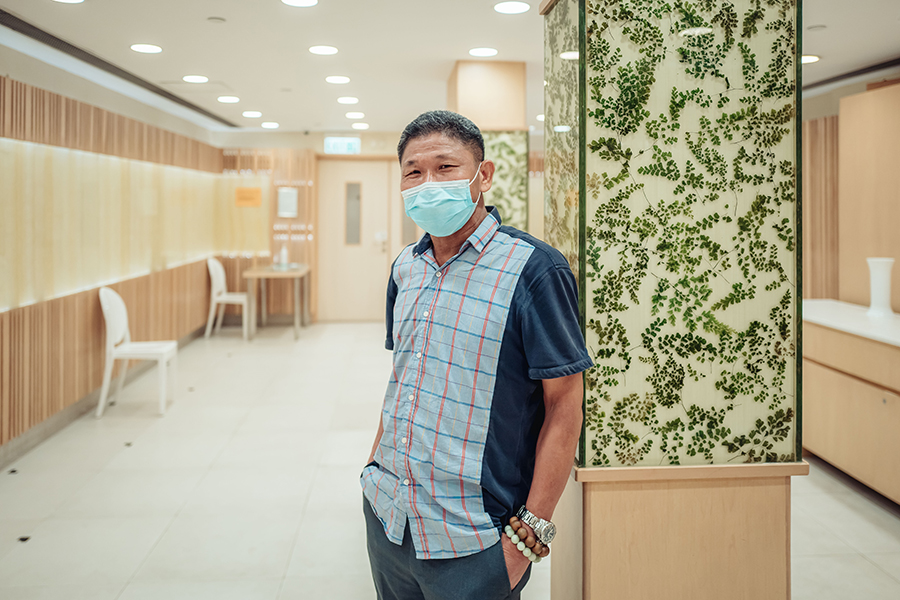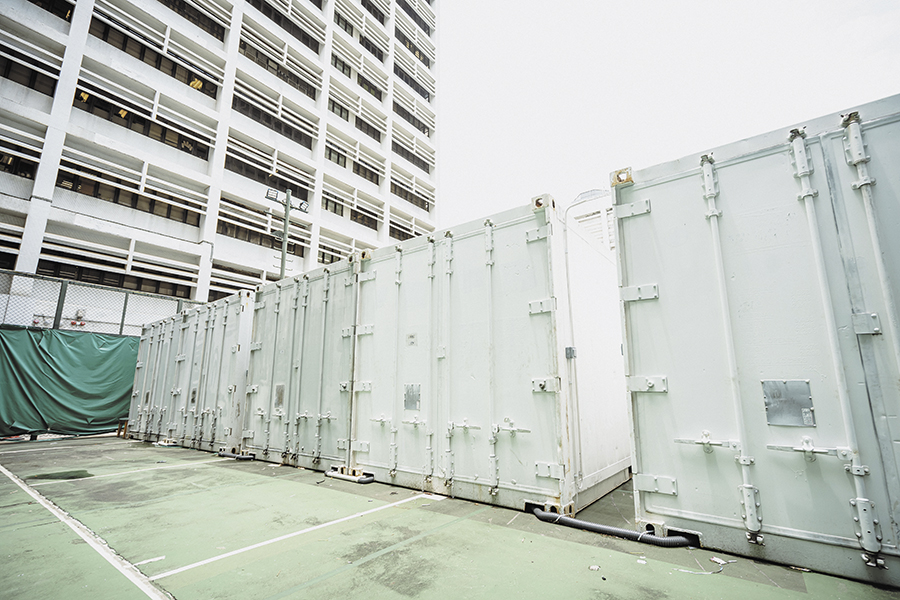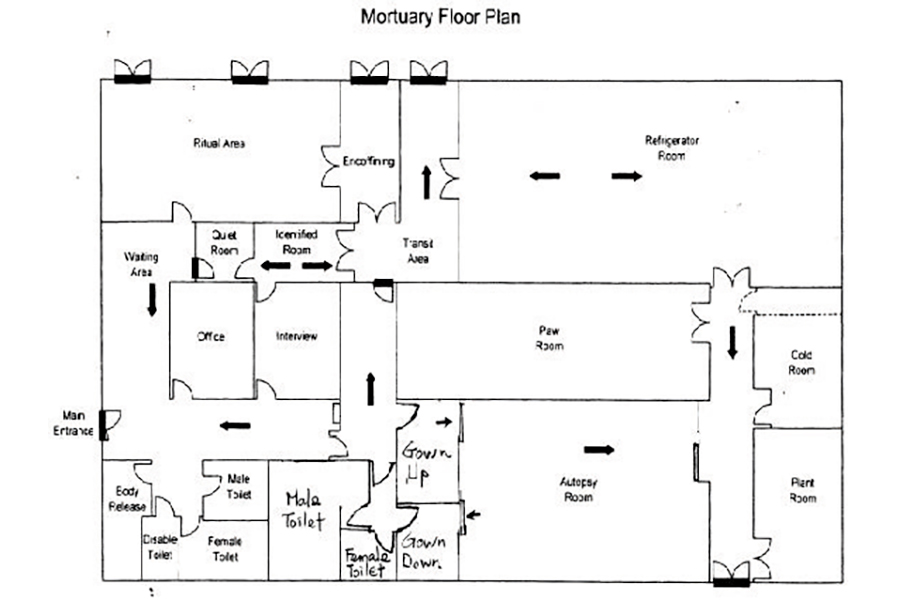
Stepping into the inconspicuous corner on the LG floor of Block B in Queen Elizabeth Hospital (QEH), you may discover a hidden world.
Lam Ming-fai (below photo), Mortuary Officer of QEH, proficiently introduced this underground world. From the reception to the autopsy room and the Hall of Eternal Peace, the use of space and every passage were deliberately designed – while the blueprint was prepared by Lam. As a ‘guardian’ of mortuary for over 20 years, Lam is going to retire at the end of this year. He has witnessed several reforms in the mortuary and experienced its hardest time in the fight against the fifth wave of the COVID-19 epidemic.

During the fifth wave, the number of deceased increased drastically and exceeded the capacity of most of the mortuaries, especially in QEH which was converted into a designated hospital for COVID-19 patients. Lam acknowledges that the peak of the fifth wave was an unprecedented crisis for mortuary service. Almost hundreds of bodies were received by the mortuary every day and bodies had to be placed temporarily in corridor, autopsy room and even the Hall of Eternal Peace. Fortunately, the mortuary colleagues worked together to overcome the hardship. “The top priority at the time was to ensure the number and information of bodies were accurate and available for checking at any time. For those bodies that were temporarily placed outside of the compartments, we arranged them with numbers to facilitate data entry. Together with daily manual counting, a smooth procedure was gradually developed.” QEH subsequently added reefers and employed outsourced staff to help receive and transfer bodies. Eventually, the mortuary could resume normal operations.
Colleagues worked together to overcome the fifth wave
In view of the epidemic, the farewell rooms or similar facilities were not open to the public. Out of the families’ wish to farewell their loved ones, with the coordination by the Head Office, hospitals would make flexible arrangement subject to their local operation and situation. For example, the families and funeral companies were able to dress up the body with a short farewell at QEH. “At that time, about 30 to 40 families would turn up for body collection every day, which was two to three times of the usual. Each family could only stay for half an hour and families were with mutual understanding,” says Lam.

Lam joined QEH as a Mortuary Officer in 1997. He recalls the mortuary was one-third the scale of what it is now. “There were merely three ventilation fans in a 600 sq. ft. autopsy room. After a day of hard work, my clothes were full of odor that I had to change before going home.” Because of space issue, when he met the families every morning, his colleagues had to cease transferring bodies. “There was only one doorway back then but it was generally a taboo for the families and the deceased to share the same doorway,” says Lam.

The QEH mortuary then underwent two renovations and was enlarged twice the original size, with refined facilities and passage design as well as increased body compartments from 60 to almost 300. Lam says that the period after Chinese New Year is usually the ‘peak season’ for the mortuary. “Winter service surge is always a challenge to mortuary service; and traditionally, people avoid funeral arrangements before Lantern Festival, so more bodies are received after that.”
Handle the body properly to ease families’ grief
Criticism is more often received in the mortuary than compliments. Lam, being a veteran, states that remaining calm, empathetic and patient is a must. “This is the worst moment for the families and they may unavoidably become moody. We should observe their emotions and stay objective in the communication. We walk them through the final step of their beloved’s journey and help them move on to their normal life as early as possible.”

 Stepping into the inconspicuous corner on the LG floor of Block B in Queen Elizabeth Hospital (QEH), you may discover a hidden world. Lam Ming-fai (below photo), Mortuary Officer of QEH, proficiently introduced this underground world. From the reception to the autopsy room and the Hall of Eternal Peace, the use of space and every passage were deliberately designed – while the blueprint was prepared by Lam. As a ‘guardian’ of mortuary for over 20 years, Lam is going to retire at the end of this year. He has witnessed several reforms in the mortuary and experienced its hardest time in the fight against the fifth wave of the COVID-19 epidemic.
Stepping into the inconspicuous corner on the LG floor of Block B in Queen Elizabeth Hospital (QEH), you may discover a hidden world. Lam Ming-fai (below photo), Mortuary Officer of QEH, proficiently introduced this underground world. From the reception to the autopsy room and the Hall of Eternal Peace, the use of space and every passage were deliberately designed – while the blueprint was prepared by Lam. As a ‘guardian’ of mortuary for over 20 years, Lam is going to retire at the end of this year. He has witnessed several reforms in the mortuary and experienced its hardest time in the fight against the fifth wave of the COVID-19 epidemic.
 During the fifth wave, the number of deceased increased drastically and exceeded the capacity of most of the mortuaries, especially in QEH which was converted into a designated hospital for COVID-19 patients. Lam acknowledges that the peak of the fifth wave was an unprecedented crisis for mortuary service. Almost hundreds of bodies were received by the mortuary every day and bodies had to be placed temporarily in corridor, autopsy room and even the Hall of Eternal Peace. Fortunately, the mortuary colleagues worked together to overcome the hardship. “The top priority at the time was to ensure the number and information of bodies were accurate and available for checking at any time. For those bodies that were temporarily placed outside of the compartments, we arranged them with numbers to facilitate data entry. Together with daily manual counting, a smooth procedure was gradually developed.” QEH subsequently added reefers and employed outsourced staff to help receive and transfer bodies. Eventually, the mortuary could resume normal operations.
During the fifth wave, the number of deceased increased drastically and exceeded the capacity of most of the mortuaries, especially in QEH which was converted into a designated hospital for COVID-19 patients. Lam acknowledges that the peak of the fifth wave was an unprecedented crisis for mortuary service. Almost hundreds of bodies were received by the mortuary every day and bodies had to be placed temporarily in corridor, autopsy room and even the Hall of Eternal Peace. Fortunately, the mortuary colleagues worked together to overcome the hardship. “The top priority at the time was to ensure the number and information of bodies were accurate and available for checking at any time. For those bodies that were temporarily placed outside of the compartments, we arranged them with numbers to facilitate data entry. Together with daily manual counting, a smooth procedure was gradually developed.” QEH subsequently added reefers and employed outsourced staff to help receive and transfer bodies. Eventually, the mortuary could resume normal operations.
 Lam joined QEH as a Mortuary Officer in 1997. He recalls the mortuary was one-third the scale of what it is now. “There were merely three ventilation fans in a 600 sq. ft. autopsy room. After a day of hard work, my clothes were full of odor that I had to change before going home.” Because of space issue, when he met the families every morning, his colleagues had to cease transferring bodies. “There was only one doorway back then but it was generally a taboo for the families and the deceased to share the same doorway,” says Lam.
Lam joined QEH as a Mortuary Officer in 1997. He recalls the mortuary was one-third the scale of what it is now. “There were merely three ventilation fans in a 600 sq. ft. autopsy room. After a day of hard work, my clothes were full of odor that I had to change before going home.” Because of space issue, when he met the families every morning, his colleagues had to cease transferring bodies. “There was only one doorway back then but it was generally a taboo for the families and the deceased to share the same doorway,” says Lam.
 The QEH mortuary then underwent two renovations and was enlarged twice the original size, with refined facilities and passage design as well as increased body compartments from 60 to almost 300. Lam says that the period after Chinese New Year is usually the ‘peak season’ for the mortuary. “Winter service surge is always a challenge to mortuary service; and traditionally, people avoid funeral arrangements before Lantern Festival, so more bodies are received after that.”
The QEH mortuary then underwent two renovations and was enlarged twice the original size, with refined facilities and passage design as well as increased body compartments from 60 to almost 300. Lam says that the period after Chinese New Year is usually the ‘peak season’ for the mortuary. “Winter service surge is always a challenge to mortuary service; and traditionally, people avoid funeral arrangements before Lantern Festival, so more bodies are received after that.”
